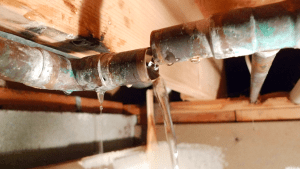Exactly how to Discover and Repair Water Leaks-- A Comprehensive Overview
Exactly how to Discover and Repair Water Leaks-- A Comprehensive Overview
Blog Article
This post in the next paragraphs on the subject of Leaking water lines is especially attention-grabbing. You should investigate it.

Early detection of leaking water lines can mitigate a potential disaster. Some tiny water leaks might not be noticeable.
1. Take A Look At the Water Meter
Every residence has a water meter. Inspecting it is a surefire way that aids you uncover leaks. For beginners, turn off all the water sources. Make certain nobody will purge, make use of the tap, shower, run the cleaning device or dishwashing machine. From there, most likely to the meter and watch if it will certainly transform. Given that no one is using it, there ought to be no motions. If it moves, that shows a fast-moving leakage. If you detect no changes, wait an hour or 2 as well as inspect back once again. This means you might have a sluggish leakage that can also be underground.
2. Examine Water Consumption
If you identify unexpected modifications, in spite of your consumption being the very same, it indicates that you have leaks in your plumbing system. A sudden spike in your costs suggests a fast-moving leak.
A steady boost every month, even with the very same routines, reveals you have a slow leak that's additionally slowly escalating. Call a plumber to extensively check your building, particularly if you feel a cozy area on your flooring with piping beneath.
3. Do a Food Coloring Test
When it comes to water usage, 30% comes from commodes. Examination to see if they are running properly. Decrease specks of food color in the container and wait 10 minutes. If the shade somehow infiltrates your dish throughout that time without flushing, there's a leakage between the tank as well as dish.
4. Asses Exterior Lines
Do not fail to remember to inspect your outside water lines as well. Ought to water seep out of the connection, you have a loosened rubber gasket. One little leak can lose heaps of water and increase your water expense.
5. Examine and also Assess the Scenario
Homeowners must make it a practice to examine under the sink counters and also even inside cupboards for any bad odor or mold and mildew growth. These 2 red flags indicate a leakage so timely focus is needed. Doing routine evaluations, even bi-annually, can conserve you from a major problem.
If you know your residence is already old, keep a careful eye on your heating systems, hoses, pipelines and so on. Look for stainings and also damaging as the majority of home appliances and pipelines have a life expectancy. They will certainly likewise naturally weaken because of wear and tear. Don't wait for it to rise if you presume leaking water lines in your plumbing system. Call an expert plumber immediately so you don't end up with a dreadful mess in your house.
Early detection of dripping water lines can alleviate a prospective catastrophe. Some tiny water leakages may not be visible. Examining it is a guaranteed way that helps you discover leaks. One little leakage can squander lots of water and increase your water expense.
If you think dripping water lines in your plumbing system, do not wait for it to escalate.
How to Know If Your Home Has a Hidden Leak
Water Meter Reveals Inexplicable Water Usage
If you’d like to test whether or not there’s a leak somewhere in your home, you can do this using your water meter. Here is how to conduct the test:
Don’t use any water in your home for at least 30 minutes; this also means not turning on faucets or water-using appliances.
Go outside, and check your water meter for activity.
If your water meter shows that there was activity, even though no one was using any water, this proves that there is a leak in your home.Visible Mold or Mildew Growth
Leaks behind walls create moist, dark environments that allow mold and mildew to grow and thrive. Eventually, you might see mold growth forming on the wall closest to a hidden leak.
If mold is growing in an area that receives a high amount of moisture, such as a bathroom, it may simply be an indication that better ventilation is needed. However, if you see mold growth on a wall or the ceiling in an area where you would not expect, you probably have a hidden leak.
Musty, Mildew Odor
Sometimes you might not be able to see the mold or mildew that is growing as a result of a leak. However, the smell can give the problem away just as easily. If you catch a whiff of something musty, there’s a good chance that old water is collecting somewhere in your home that you can’t see.
Stained/Warped Walls, Ceilings, or Floors
When your home soaks up water, a variety of red flags can become visible, including ceiling stains, bubbling drywall, warped walls, and sagging floors. While these issues can be caused by excess humidity, they can also be signs that a pipe or plumbing connection has started leaking behind your walls.
Inexplicably High Water Bill
After a while, you get a general sense for what your water bill should be. If you own a pool or sprinkler system, your bill will tend to be higher during summer. However, if you receive a water bill that seems especially high, and you can’t figure out what caused it, then you may have a hidden leak somewhere that’s increasing your bill.
https://www.plumbingjoint.com/blog/2019/july/how-to-know-if-your-home-has-a-hidden-leak/

I stumbled upon that blog post on Finding hidden leaks while browsing the web. Those who enjoyed our page please do not forget to share it. Thank you for your time. Please come by our site back soon.
Report this page